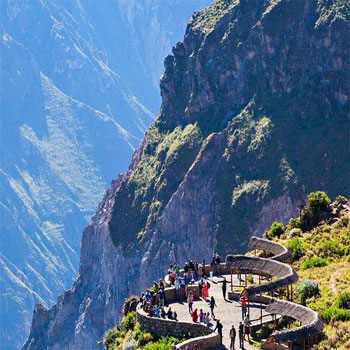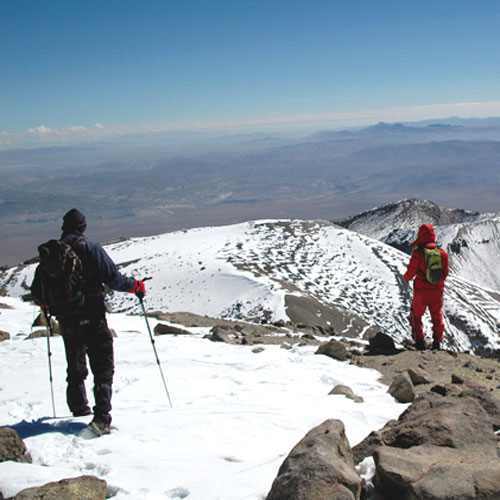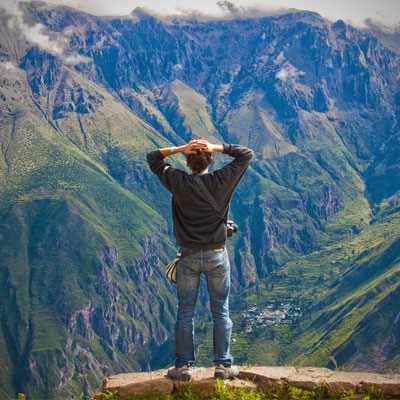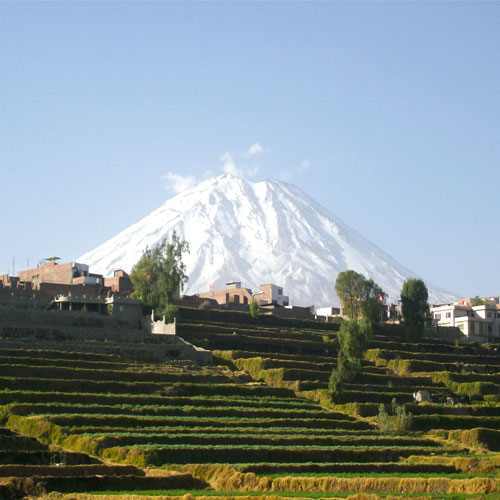Arequipa (7638ft above sea level) is located in the southwestern part of the country, spanning from coastal desert, with 328mi of Pacific coast, to the spurs of the western Andes. Its horizon is dominated by three volcanoes, snow-capped Chachani and Pichu Picchu with the perfectly conical El Misti Volcano in the center. El Misti (19,098ft) is fondly considered a symbol of the city and culture of Arequipa. There are other glacial peaks aside from Chachani and Pichu Picchu, the tallest being Mt. Ampato (20,702ft), where some of the most well-preserved and oldest ice mummies of the continent have been found. You can view some at the Museum of Andean Sanctuaries, home of the world-famous Juanita the Ice Maiden mummy of a girl sacrificed seven hundred years ago.
Behind snowy Chachani, the Cañahuas Plains in the National Reserve of Aguada Blanca and Salinas protect grazing vicuña herds nearby the Caves of Sumbay with their 8000 year old Paleolithic cave paintings. The territory is diverse, with low-lying plains such as those of Sihuas and La Joya and fertile river valleys such as Majes River Valley, an attractive oasis of straw and abobe homes, vineyards, ochards, and rice paddies. It is in the Majes Valley that one can find the Toro Muerto Petroglyphs, cave and stone carvings which might date as far back as 1100AD and are believed to be the world's largest petroglyph field.
Magestic landscapes are not scarce thanks to the large sandunes of the desert and the two deepest canyons in the world; Cotahuasi Canyon, the deeper of the two, and Colca Canyon, more famous due to its circling families of endangered Andean Condors, the world's largest birds of flight. There are also large swathes of Arequipa's rugged Andean territory covered by thick layers of volcanic lava. Its most important rivers are the Tambo, Ocoña, Majes, and the Chili River, which crosses the city from north to south.
The climate is mild and relatively dry with incessantly sunny days except for the moderate rains of the January to March period. This has earned it the nickname City of the Eternal Blue Sky. Daily temperatures rarely dip below 68°F, although the nights can be cold, especially in June, July, and August when temperatures dip between 40-50°F
Archeological evidence places nomadic hunter-gatherer tribes in the Province of Arequipa as far back as 8000 years ago. It was home to the important Huari and Aymara Civilizations, with lesser cultures such as the Churajón, Chuquibamba, Yarabayas,Chimbas, Collagua, and Cabana settling here in their turn as well. Calamity struck several times in the 1400s with major eruptions by El Misti Volcano and the conquest of the Aymaras by the Inca, afterwhich Arequipa became an important agricultural providerm, the bread basket, for the Inca Empire.
The city of Arequipa was founded in 1540 as the Villa of the Assumption of Our Lady of the Beautiful Valley of Arequipa and become the south's major commercial hub shortly thereafter. In the 1600s further volcanic eruptions and multiple earthquakes nearly destroyed the disaster-prone city.
José de San Martin declared the Independence of Peru in 1821, and throughout the Wars of Independence of the 19th century, Arequipa housed many nationalist rebels, although its local civil war between nationalists and royalists kept it under the royal yoke until the decisive battle of Ayacucho in 1824. During the government of Bolívar which came into power after the Battle of Ayacucho, city intellectuals and elite actively opposed what it considered the consolidation of dictatorial powers by the Liberator through the Bolivarian constitution, leading to a number of clashes in and around the city through a succession of military rebellions and public insurrections.
It was proclaimed the capital of Peru in 1882 by Lizardo Montero, who arrived in the city along with a 4000-man army and large national guard to repel Chilean invasion during the War with Chile. A popular and military revolt against Montero unseated him, forcing him to retreat to La Paz. Throughout the 1800s and 1900s it was the cradle of a shocking number of uprisings such as those by Mariano Ignacio Prado and Nicolás de Piérola Villena, earning its name as the "Lion of the South". During this time the city also suffered multiple major earthquakes, with the latest being an 8.4 magnitude quake in 2001.



